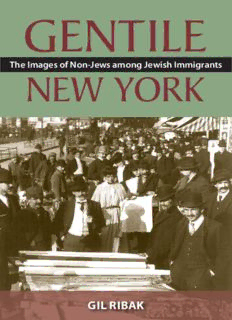
Gentile New York: The Images of Non-Jews among Jewish Immigrants PDF
Preview Gentile New York: The Images of Non-Jews among Jewish Immigrants
GENTILE The Images of Non-Jews among Jewish Immigrants NEW YORK GIL RIBAK GENTILE NEW YORK GENTILE NEW YORK The Images of Non-Jews among Jewish Immigrants Gil Ribak Rutgers University Press New Brunswick, New Jersey, and London Library of Congress Cataloging-in-Publication Data Ribak, Gil. Gentile New York : the images of non-Jews among Jewish immigrants / Gil Ribak. p. cm. Includes bibliographical references and index. ISBN 978–0–8135–5164–7 (hardcover : alk. paper) 1. Jews—New York (State)—New York—Attitudes. 2. Gentiles—Public opinion. 3. Public opinion—New York (State)—New York. 4. Immigrants—New York (State)— New York—Attitudes. 5. Jews—New York (State)—New York—History—19th century. 6. Jews—New York (State)—New York—History—20th century. 7. New York (N.Y.)— Ethnic relations. I. Title. II. Title: Images of non-Jews among Jewish immigrants. F128.9.J5R44 2012 305.8009747—dc22 2011010860 A British Cataloging-in-Publication record for this book is available from the British Library. Copyright © 2012 by Gil Ribak All rights reserved No part of this book may be reproduced or utilized in any form or by any means, electronic or mechanical, or by any information storage and retrieval system, without written permis- sion from the publisher. Please contact Rutgers University Press, 100 Joyce Kilmer Avenue, Piscataway, NJ 08854–8099. The only exception to this prohibition is “fair use” as defi ned by U.S. copyright law. Visit our Web site: http://rutgerspress.rutgers.edu Manufactured in the United States of America To my parents Eliezer of blessed memory and Bruria, may she be set apart for long life Contents Acknowledgments — ix A Note on Transliteration — xi Introduction — 1 1 “Never Before Have Gentiles Hated Jews So Much”: The Images of Non-Jews in Eastern European Jewish Society in the Late Nineteenth Century — 12 2 “Lovers of Man”: The Images of Americans among Eastern European Jews in the Last Third of the Nineteenth Century — 34 3 “In Goodness They Even Exceed the English”: The Idealization of “Yankees” in the 1880s and 1890s — 52 4 “The American Is Not Very Musical and Not So Sociable”: The Beginnings of an Attitudinal Change in the Early 1900s — 76 5 “You Could Almost Forget That He Is Not a Jew”: The Jewish Labor Movement and Secularized Chosenness, 1909–1914 — 101 6 “The ‘Green’ Italian Pays the Same Good Taxes as the 14-Karat Yankee”: The War in Europe and the Beginnings of Reorientation toward Certain Minority Groups, 1914–1917 — 126 7 “What the American Can Do in His Anger”: World War I and the Red Scare, 1917–1920 — 156 Epilogue: Self-Image and Its Limitations — 188 A Note on Methodology and Sources — 199 Notes — 203 Index — 283 Acknowledgments It is a pleasant duty to express my gratitude to the many individuals and institutions that have supported and assisted the publication of this book. A number of scholars have read diff erent versions of my work and pro- vided me with perceptive comments: at the dissertation stage my advisor, Tony Michels, and David Sorkin prodded me into rethinking my project. Bill Reese’s and Mark Louden’s friendliness and advice were a signifi cant source of support. Jeremi Suri was always an invaluable powerhouse of suggestions and encouragement. Other historians, such as Thomas Arch- deacon, Paul Boyer, Stanley Cutler, and Stanley Schultz, were models of scholarship and expertise throughout my years in Madison, Wisconsin. I was very fortunate to have colleagues like Pamela Barmash, Hil- lel J. Kieval, and Rafi a Zafar at Washington University in St. Louis. Their amicability and understanding contributed much to my development as a scholar. I am equally blessed to have colleagues such as Beth Alpert Nakhai, David L. Graizbord, Tom Kovach, Anat Maimon, and J. Edward Wright at the Arizona Center for Judaic Studies, University of Arizona. Their spirited companionship has given me the perfect intellectual and social environment during the fi nal stages of preparing my manuscript for publication. Over the years I had the privilege and pleasure of meet- ing several scholars who off ered invaluable insights into my embryonic book, like Israel Bartal, Hasia R. Diner, Jonathan Karp, Nancy Sinkoff , and Gary P. Zola. Throughout my career Arnon Gutfeld has exhibited a remarkable degree of friendship and kindness, and I am deeply indebted to him. I would like to thank the anonymous readers of my manuscript, who have made very helpful suggestions. Needless to say, all errors remain mine. I am also grateful to the various institutions and foundations that helped fund my work. I benefi ted from the generosity of the Kenneth Kitting and Zalman Aran Fellowships, the Institute of International Edu- cation and the Fulbright Foundation, the Wisconsin Distinguished Grad- uate Fellowship and the Mosse Advanced Dissertator Lectureship (the last two were both granted by the George L. Mosse Program in History at the University of Wisconsin–Madison), the Center for German and European Studies at UW-Madison, and the Lewin Postdoctoral Fellow- ship at Washington University in St. Louis. Finally, I am thankful to the ix
Description: